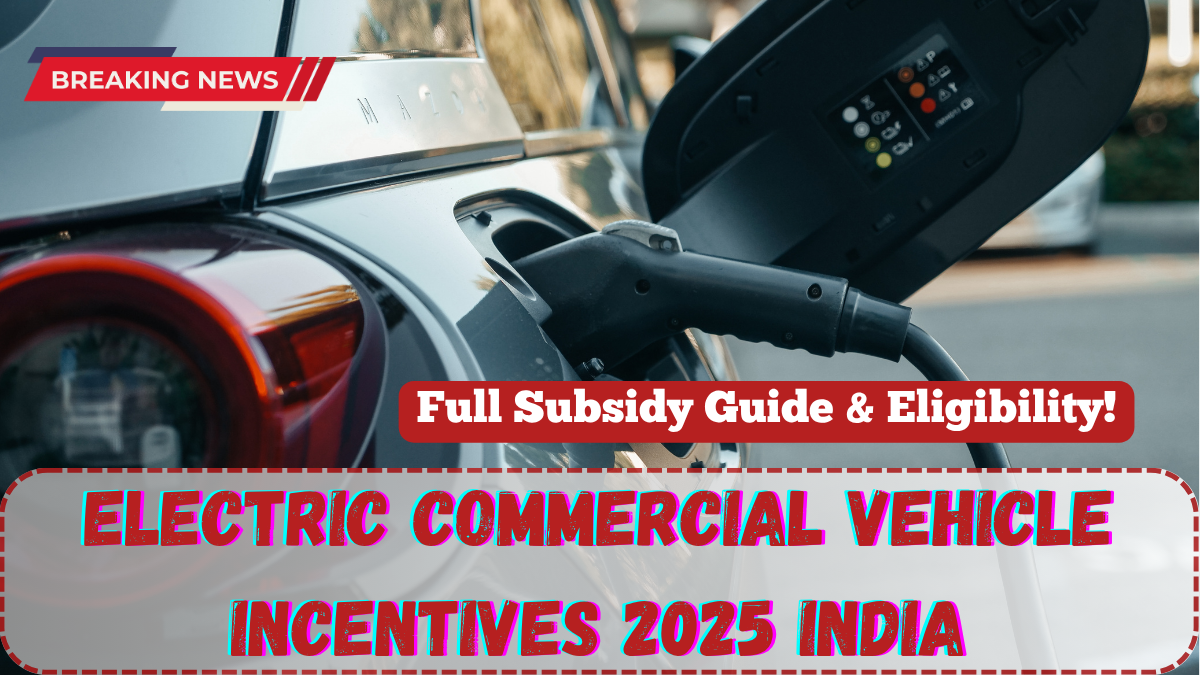The Electric Commercial Vehicle Incentives 2025 India are now live, providing targeted financial and policy support to logistics companies, transport operators, and fleet owners looking to switch from diesel-based vehicles to clean electric alternatives. Backed by the Ministry of Heavy Industries and the FAME-II and FAME-III schemes, this initiative directly promotes the adoption of EV trucks, vans, and buses for commercial use.
With India’s rising focus on reducing emissions and fuel dependence, the EV trucks subsidy under this program is helping drive faster fleet electrification across metros, highways, and last-mile delivery routes.

What is the Electric Commercial Vehicle Incentives 2025 Scheme?
The Electric Commercial Vehicle Incentives 2025 India is a dedicated government initiative offering subsidies, tax exemptions, and registration benefits for commercial EV adoption. The goal is to replace at least 20% of India’s commercial diesel fleet with electric vehicles by the end of the fiscal year.
Key components of the scheme:
-
Capital subsidy of up to ₹12 lakh per electric commercial vehicle
-
Scrappage incentives for retiring old diesel trucks
-
GST reduction from 18% to 5% on EV purchases
-
Road tax and registration fee waiver in participating states
-
Fast-track approvals for fleet financing under priority lending
This comprehensive EV trucks subsidy framework benefits both small fleet operators and large logistics companies.
Types of Vehicles & Models Covered Under the Scheme
The Electric Commercial Vehicle Incentives 2025 India apply to a wide variety of electric vehicle categories, specifically aimed at the commercial transport sector. From e-trucks to electric buses and cargo loaders, the coverage has been expanded in 2025.
Approved vehicle types include:
-
Light Commercial Vehicles (LCVs) – electric pickup vans, delivery vans
-
Medium and Heavy Commercial Vehicles (M&HCVs) – e-trucks and cargo haulers
-
Electric Buses – intercity and intracity mass transport buses
-
Three-Wheeler Cargo EVs – for hyperlocal delivery and last-mile logistics
Popular approved models (as of 2025):
-
Tata Ultra T.7 EV
-
Mahindra Treo Zor
-
Switch Mobility eLCV
-
Ashok Leyland ecomet Star
-
PMI Electric Buses
-
Omega Seiki Mobility Rage+ Cargo
All models must be approved by the Ministry of Road Transport & Highways and registered under the e-Vahan database to qualify for the fleet electrification subsidy.
Eligibility and Financial Benefits
The Electric Commercial Vehicle Incentives 2025 India are designed to be inclusive and accessible for transport businesses of all sizes.
Eligibility criteria:
-
Must be a registered logistics, transport, or fleet management company in India
-
Vehicles purchased must be listed under the official approved EV list
-
Purchase must be made from a certified dealer with invoice and VIN tracking
-
Individual buyers owning 3+ vehicles are also eligible under fleet category
-
Applicants must provide GST number, company registration, and PAN
Financial benefits offered:
-
Capital subsidy of ₹2 lakh–₹12 lakh depending on vehicle type and battery capacity
-
Interest subvention on EV loans via public banks and NBFCs
-
Priority access to state-supported charging infrastructure
-
Additional ₹25,000–₹50,000 scrappage bonus for de-registering older diesel vehicles
This makes switching to electric vehicles highly affordable and practical in both short-haul and long-haul operations.
Impact of the Scheme on Fleet Electrification in 2025
The rollout of the Electric Commercial Vehicle Incentives 2025 India has led to a visible shift in how goods and people are moved across the country. Major logistics and transport companies have already begun large-scale procurement of electric trucks and buses.
Notable results include:
-
Over 35,000 electric commercial vehicles added in the first half of 2025
-
Fleet emissions reduced by an estimated 1.8 million tons of CO₂
-
Faster delivery turnaround in urban logistics due to lower operating costs
-
Expansion of charging depots and swappable battery stations along highways
-
Creation of new green jobs in EV servicing, battery manufacturing, and driving
India’s transportation sector is now embracing clean energy at scale, thanks to aggressive EV trucks subsidy policies and supportive state-level initiatives.
FAQs
What is the Electric Commercial Vehicle Incentives 2025 India?
It is a government scheme offering financial subsidies, tax relief, and infrastructure support to promote electric commercial vehicles across India.
Who is eligible for EV trucks subsidy?
Registered fleet owners, transport companies, e-commerce logistics providers, and individuals with three or more commercial EVs are eligible.
What kind of vehicles are covered under the scheme?
The scheme covers electric trucks, vans, buses, and three-wheeler cargo vehicles that are listed in the approved government EV model database.
How much subsidy can I get per electric vehicle?
You can receive up to ₹12 lakh per vehicle, depending on the battery capacity and type of vehicle purchased.
Are state-level benefits also available?
Yes, many states offer additional perks such as road tax waivers, interest subsidies, and exclusive parking zones for electric fleets.
Click here to know more.
